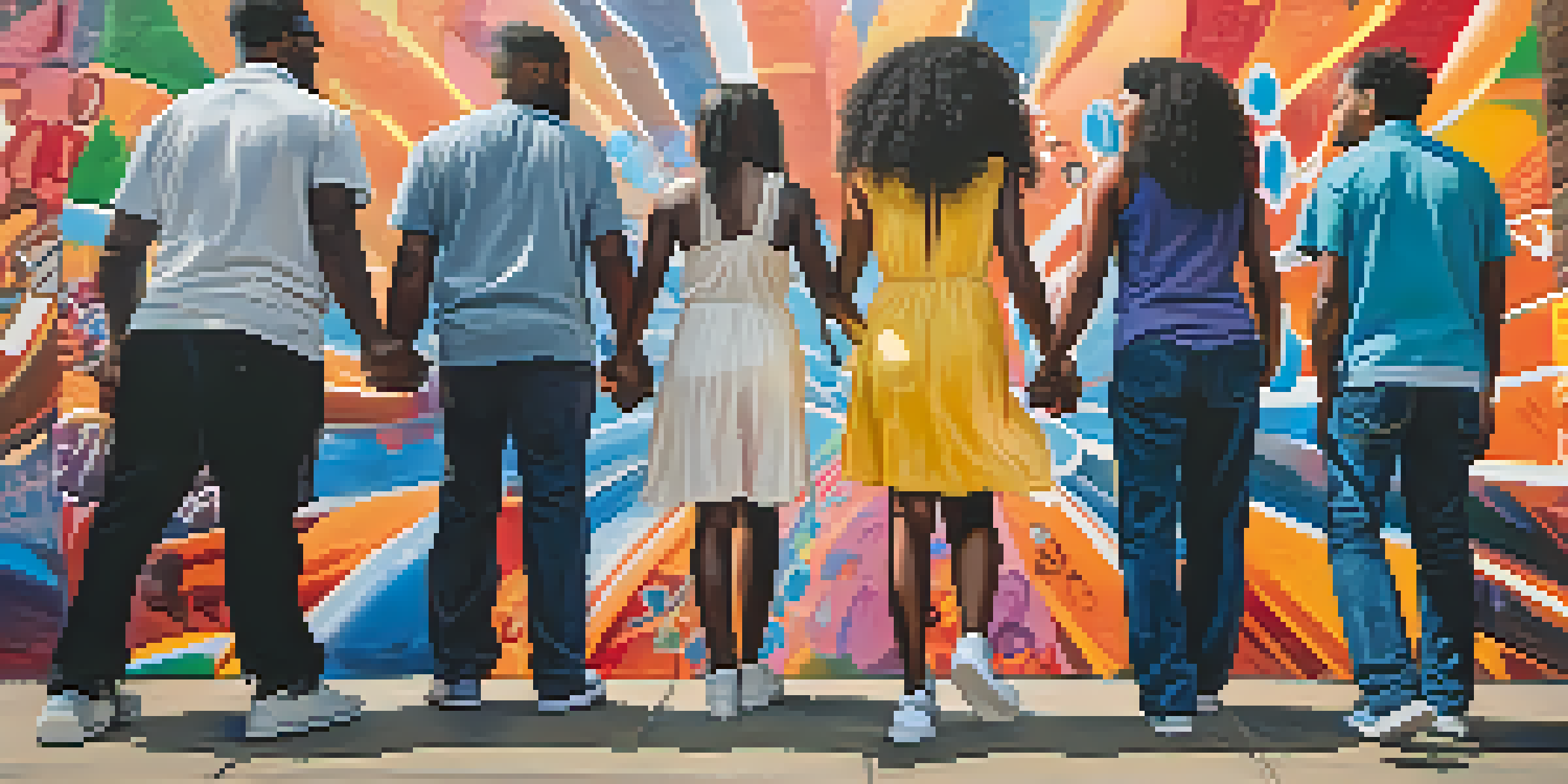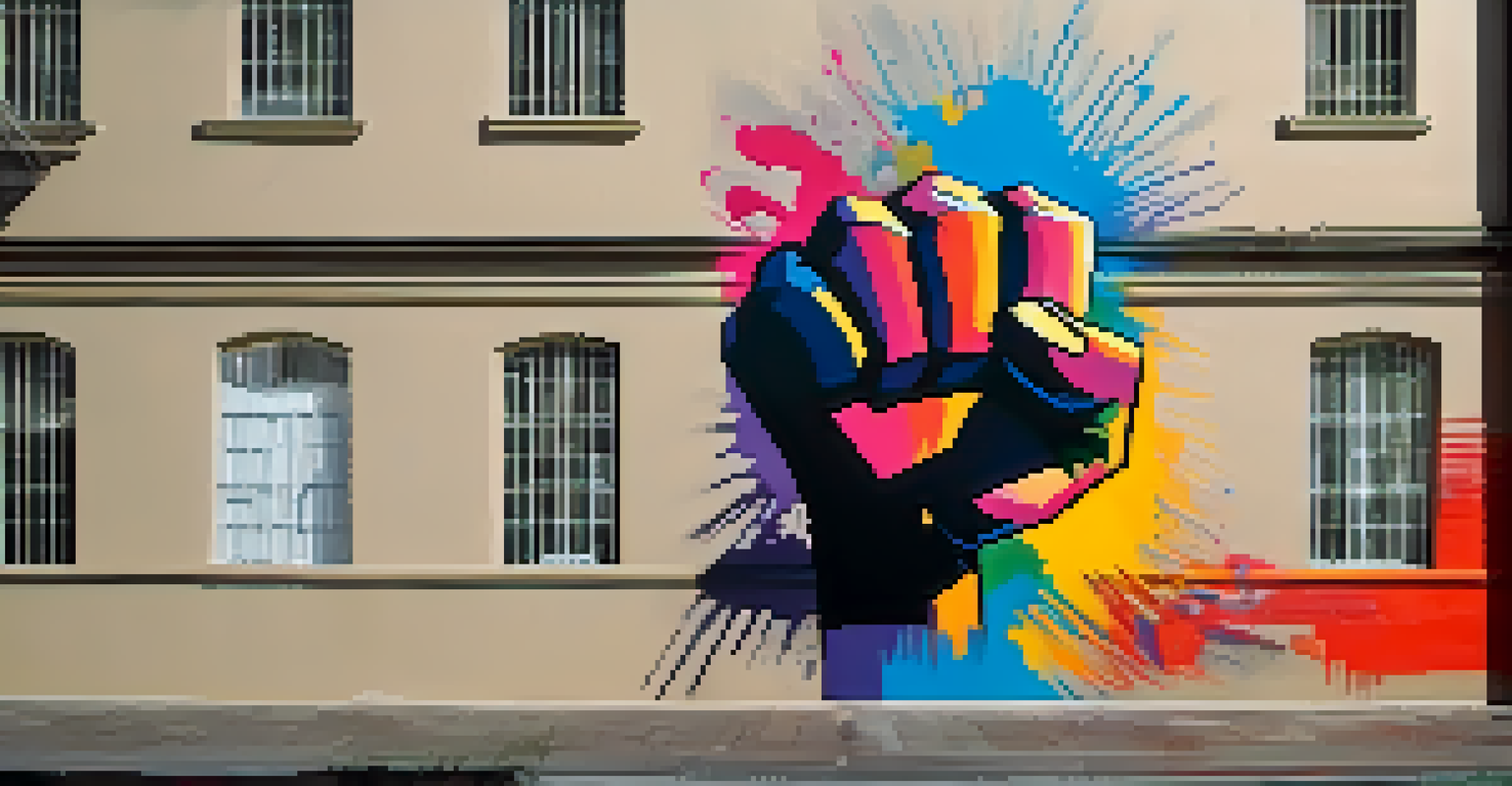The Legacy of Protest Art Throughout History

Understanding Protest Art: Definition and Importance
Protest art is a powerful form of expression that challenges societal norms and injustices. It encompasses various mediums, including painting, music, performance, and literature. By articulating dissent and advocating for change, protest art plays a crucial role in social movements.
Art is not freedom of choice. It is rather a freedom of necessity.
Throughout history, artists have used their creativity to reflect the struggles of their time, making complex issues accessible to the public. This type of art not only raises awareness but also inspires collective action. For instance, the vivid murals of the Mexican Revolution captured the spirit of the people and their desire for change.
In essence, protest art serves as a voice for the marginalized, often articulating feelings of anger, hope, and resilience. It invites viewers to engage with pressing social issues, fostering a sense of community and purpose. As we explore its legacy, we uncover how it has shaped movements across time.
Historical Roots: Protest Art in Ancient Civilizations
The roots of protest art can be traced back to ancient civilizations, where artists often used their work to comment on political and social issues. For example, in ancient Greece, pottery and sculptures depicted scenes that critiqued the political landscape. These art forms served as both a reflection of society and a call for change.

Similarly, ancient Egyptian art often portrayed the struggles of the people against oppressive rulers, encapsulating their hopes and desires for justice. These early forms of protest art highlight how creativity has been a tool for resistance for centuries.
Protest Art as Social Commentary
Protest art challenges societal norms and injustices, serving as a voice for the marginalized and inspiring collective action.
By examining these historical examples, we see that the desire for social justice is not a modern phenomenon. Instead, it has been a driving force behind artistic expression throughout history, laying the groundwork for future movements.
The Renaissance: Art as a Tool for Political Commentary
During the Renaissance, artists like Leonardo da Vinci and Michelangelo began to use their work to comment on the political and social issues of their time. Their masterpieces often contained subtle critiques of authority and societal norms, encouraging viewers to question the status quo.
The role of the artist is to make the revolution irresistible.
For instance, Michelangelo's 'David' is more than a representation of a biblical figure; it symbolizes the struggle against tyranny and the fight for freedom. Such artworks contributed to a cultural shift that valued individualism and critical thought.
This period showcases how protest art evolved from mere representation to a more explicit form of social critique, influencing generations of artists to use their platforms for advocacy.
The 20th Century: Protest Art in Times of War and Civil Rights
The 20th century witnessed an explosion of protest art, particularly during times of war and civil rights movements. Artists like Pablo Picasso used their work to respond to the horrors of war, as seen in his iconic painting 'Guernica,' which powerfully conveys the devastation of the Spanish Civil War.
Simultaneously, the civil rights movement in the United States inspired a wave of artistic expression that highlighted racial injustice. From music to visual art, creators like Nina Simone and the Black Arts Movement used their talents to advocate for equality and challenge systemic racism.
Historical Roots of Protest Art
Throughout history, from ancient civilizations to the Renaissance, artists have used their creativity as a tool for political commentary and social critique.
These artists not only documented the struggles of their time but also rallied people around the cause, demonstrating the profound impact of protest art on social change.
Modern Protest Art: Digital Age and Global Reach
In today's digital age, protest art has taken on new forms and reached a global audience. Social media platforms have become powerful tools for artists to share their work and amplify their messages. This democratization of art allows for a wider range of voices to be heard, transcending geographical boundaries.
Contemporary artists like Banksy use street art to comment on social issues, challenging viewers to confront uncomfortable truths. His works often provoke thought and dialogue, highlighting the role of anonymity in protest art.
The ability to share art instantly has transformed how movements are organized and perceived, proving that protest art remains relevant and necessary in the fight for justice.
Impact of Protest Art on Social Movements
Protest art has a unique ability to unite people and galvanize social movements. Through its emotional resonance, it can inspire individuals to take action, turning passive observers into active participants. The iconic 'We Can Do It!' poster featuring Rosie the Riveter became a symbol of female empowerment during World War II, motivating women to join the workforce.
Moreover, protest art often serves as a historical record of movements, preserving stories and experiences for future generations. This documentation ensures that the struggles and triumphs are not forgotten, fostering a sense of continuity in the fight for justice.
Modern Innovations in Protest Art
In the digital age, protest art has evolved with new technologies, allowing artists to reach global audiences and engage them in social issues.
Ultimately, the impact of protest art extends beyond aesthetics; it shapes cultural narratives and influences public perception, making it a vital component of any social movement.
Challenges Faced by Protest Artists
Despite its significance, protest art often faces challenges, including censorship and backlash from authorities. Artists risking their careers and safety to express dissent can find themselves at odds with powerful entities. For example, Ai Weiwei, a Chinese artist, faced government persecution for his outspoken criticism of the Chinese regime.
Additionally, the commercialization of protest art can dilute its message, as some artists struggle to maintain authenticity in a market-driven world. This tension raises questions about the role of art in activism and the ethics of profit in protest.

Navigating these challenges requires courage and resilience, reminding us that the act of creating protest art is, in itself, a form of resistance against oppression.
The Future of Protest Art: Trends and Innovations
As we look to the future, protest art continues to evolve, incorporating new technologies and trends. Virtual reality, augmented reality, and interactive installations are emerging as innovative ways for artists to engage audiences and create immersive experiences around social issues.
Furthermore, collaborations between artists and activists are becoming more common, blurring the lines between art and activism. This synergy enhances the impact of their messages, reaching wider audiences and fostering deeper connections.
Ultimately, the future of protest art holds exciting possibilities, as it remains an essential medium for advocating change and amplifying voices that demand to be heard.